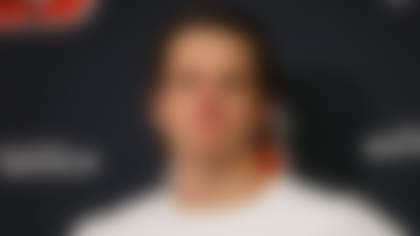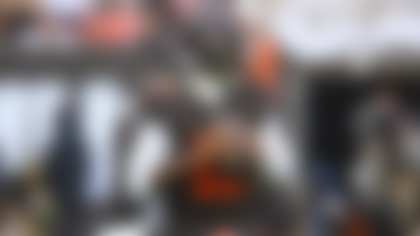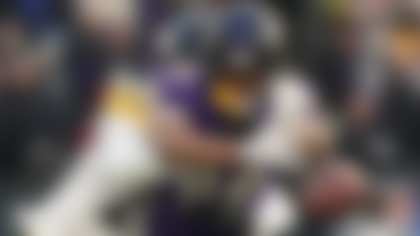SAN DIEGO, Calif. -- As the seconds ticked away toward their AFC Championship Game victory over the Pittsburgh Steelers in January 1995, the San Diego Chargers began to celebrate.
Linebacker David Griggs, who moments before had leaped high in the air when teammate Dennis Gibson knocked away a fourth-down pass to preserve a 17-13 victory, exuberantly tackled Gibson along the sideline, screaming in triumph.
Ex-Charger: 'This isn't normal'
Junior Seau's death last week left one former Charger wondering if the 1994 AFC Championship team is jinxed. **More ...**
Moments later, NBC cameras captured defensive end Chris Mims, accompanied by linebacker Doug Miller, derisively waving a Terrible Towel at the hometown fans.
Soon, Junior Seau was wrapping Gibson in a crushing bear hug.
It was a cold, wet, gray late afternoon in the Steel City, but the Chargers -- and their fans back home -- were overcome by the joy of their upset and the realization the team would be going to its first Super Bowl.
Seventeen years later, Gibson remembers the game in detail. He says the fourth-down knockdown was the highlight of his career.
Yet the joy he felt from that season and the pride he took in that band of brothers is now clouded by sadness. Eight members of that team -- including Griggs, Mims, Miller and Seau -- have died. All were in their 20s, 30s or early 40s.
Gibson, who today owns and operates a pizza place in Johnston, Iowa, says he once looked forward to a reunion of that team.
Now, everything feels different.
"I thought, It's kind of coming up on the 20th anniversary of that thing," he said. "Maybe the Chargers will do something, you know, a celebration. That would be a time to get back out there and get together with some of the guys. Well, heck, a bunch of them are gone already. It's just one of those strange deals."
The deaths have caused some Chargers to reach out to one another from long distance, looking to re-connect while searching for answers. Why have so many good friends and teammates been lost?
"It's crazy," said former tight end Al Pupunu, now an assistant coach at the University of Idaho. "Some people will say it's a curse, but I don't know, to be honest with you, if it's a curse or not. You take it for what it is. ... We just keep losing guys off the squad. Sometimes you think maybe it's just bad luck."
Shawn Mitchell, who's served as team pastor for 29 years, says neither he nor the players he's spoken with believe in a curse. To Mitchell, it's simply been a tragic happenstance, a statistical aberration.
When John Parrella heard the news last week that Seau committed suicide at age 43, he -- like the legions of Chargers fans across San Diego -- was shocked. Not again, he thought. Not Junior, the team's homegrown star, its future Hall of Famer.
"It's one of those deals where, unfortunately, these tragedies have caused a few of us to call or email or text to each other just because it really touches you," said Parrella, a former defensive tackle who now coaches high school football in the Bay Area.
"Especially because every couple of years it's another guy. It's sad and it's a weird, fluke thing that's happened. ... You just can't believe how it crushes you every time you hear it."
Adds Gibson: "It's hard to believe because we're all so young."
Just five months after the Chargers lost 49-26 to the San Francisco 49ers in Super Bowl XXIX, Griggs, 28 -- so full of joy at the end of the AFC Championship Game -- died in a car accident near Fort Lauderdale, Fla.
Almost a year later in May 1996, running back Rodney Culver, 26, was killed along with his wife in a crash of a ValuJet plane in Florida.
Linebacker Doug Miller, 28, was struck twice by lightning and killed while camping in Colorado in July 1998.
In May 2008, center Curtis Whitley, 39, died of a drug overdose in Texas. Five months later, Mims, 38, who weighed 456 pounds and had battled health and emotional problems, died of an enlarged heart in Los Angeles.
In February of last year, defensive tackle Shawn Lee, 44, died of a heart attack in North Carolina after battling double pneumonia.
In December, a heart attack claimed linebacker Lew Bush, 42, in Arizona.
And then last week, Seau was found dead in his Oceanside home of what was ruled a self-inflicted gunshot wound to his chest.
That's eight players off a 53-man roster -- 15 percent of the team. By contrast, the 49ers that faced the Chargers in the Super Bowl that year have lost two players, linebacker Kevin Mitchell and offensive tackle Harry Boatswain.
The number of deaths seems excessive, considering the players who died ranged in age from 24 to 28 at the time of the AFC Championship Game.
Brian Dennis, a professor in the department of statistical sciences at the University of Idaho, says calculating the odds of such an occurrence would be complex and take into account a large range of factors, but agrees it appears the Chargers of 1994 have been hit hard. It's not "out of the question," he says, that a team would have a probability less than 10 percent of losing so many players off its roster over that span.
To the Chargers, however, those are just numbers. They don't reflect the people who were part of a special team in a special year.
Mitchell knew each player well. Culver and Lee helped out often at his church in Oceanside, and Seau often attended services there.
He recalls clearly two moments with Griggs and Culver, the first to die.
During the week leading up to Super Bowl XXIX after the win in Pittsburgh, Mitchell and Griggs ate together, just the two of them.
"He related to me over breakfast his excitement at finally getting to live his boyhood dream of playing in a Super Bowl," Mitchell said. "He was enthralled about running down the tunnel, Kathie Lee (Gifford) doing the national anthem, F-16s flying over. He was just enthralled that he would be in a Super Bowl. It didn't go the way we wanted, and you know he careened off the freeway. It was very, very sad."
Culver, the former Notre Dame captain whom Mitchell says was a close friend, talked with Mitchell at a barbecue held at coach Bobby Ross' home about two weeks before he died. Culver told Mitchell that he and his wife were going to take one last trip before getting ready for training camp.
"He said, 'We're going to leave the kids with grandma' -- he had young kids -- 'and we're going to go on this trip. We're really going to miss the kids.' I said, 'Rodney, see you in two weeks,' " Mitchell recalled. "Well the next time I saw him, regrettably, was his image on the (TV) screen, with his wife."
What hits home with Mitchell, too, is that he learned later the Culvers had decided to fly home early because they missed their kids. They hadn't originally been booked on that flight.
"There was an awareness probably four years ago or so that our men were leaving us at a rather extraordinary rate," Mitchell said. "That only accelerated when you have Shawn Lee, Chris Mims ...
"So it's been very, very sobering. And now with this man (Seau), a super man, an incredible standout on the field and off, legendary linebacker and exceptional man, no longer with us and the way in which it happened, I think it has people seriously considering what's going on."
The 1994 Chargers team was special, and so was its relationship to the city of San Diego and the franchise itself.
At Chargers headquarters, where a team flag hung at half-staff this week, tangible connections to those AFC champions are everywhere.
A giant mural of the moment Gibson knocked down Neil O'Donnell's pass, with 1:08 remaining, dominates one wall of the lobby. The AFC championship trophy is displayed, as are photos of Tony Martin's touchdown catch against the Steelers and the team's parade. Upstairs, more photos and framed pages from the Union-Tribune the day after the Pittsburgh win, line a hallway.
That 1994 squad didn't match the excitement of the Air Coryell-era teams with Dan Fouts, Kellen Winslow and Charlie Joiner, or the later star-studded editions with LaDainian Tomlinson, Philip Rivers and Antonio Gates.
But unlike those teams, the '94 Chargers under Ross went to a Super Bowl, and the team did it with a pounding running game built around Natrone Means, a quarterback who could throw the long ball in Stan Humphries and a gritty defense led by Seau, a 25-year-old superstar from nearby Oceanside and USC who amazed his teammates with his speed, ferocity and energy.
Parrella, who was in his first of eight seasons in San Diego that year, said he could sense right away, after a season in Buffalo, that the Chargers had something special. And as the season progressed, everything came together.
"When I got there they had been predicted to be last in the AFC West and the first thing I thought was, 'This is a pretty good team. There's a lot of talent, a lot of guys who just played hard every play,' " he recalled of a team that had been 8-8 a year earlier. "They put together a great little team, played good defense and they could run the ball on anybody. And I think a very close team, very unified. They took me in like I knew those guys forever."
Pupunu recalls a young team that had good chemistry, good leadership and a great work ethic around just a few stars. Gibson, too, says the team had a rare chemistry and closeness.
"That's what I think you have to have when you come out of nowhere," he said. "I don't think the expectation was that high for us as a team going into the season. But we kind of came out of the gate and won six games in a row, got on fire and stayed relatively healthy. We won games in the fourth quarter and got a confidence about us. During the season we just jelled."
This week, the shock of Seau's death still hangs over the team and fans in San Diego. Private and public memorials are scheduled for Thursday and Friday.
In recent days, Seau's No. 55 jersey has been worn by fans at Padres games, at restaurants and all over San Diego County. Outside Seau's San Diego restaurant, a makeshift memorial of photos, T-shirts, footballs, signs and balloons left by fans has drawn others to come, take photos and somehow connect with a local icon.
All the losses -- from Griggs and Culver to Lee and Bush last year -- have been painful, but the loss of Seau has been especially hard.
For Parrella, who roomed in training camp with Seau and Pupunu one summer, Seau's death is hard to fathom because he was so full of life.
"Junior was just high on life," he said. "He was the happiest-go-lucky guy I've probably ever known. ... He was also a guy that all of us, I don't think I ever heard anybody say anything bad about Junior."
As the years have progressed since that season, and the sad news of one death has followed another, Pupunu says the players from '94 -- now scattered across the country -- have sought out teammates and, in some cases, tried to re-connect more often.
Pupunu still embraces that special season and all they accomplished, but he can no longer think about all the good without the bad. He sees too many faces now missing from that 1994 roster.
"We were successful, winning games, going to the playoffs, going to the highest level, and then the sadness comes with teammates -- the guys you played with and developed relationships with -- and you lose those guys, it's sad."
It's made him realize he needs to make a better effort to stay close to the people who mean the most to him. Seau was one such person. It was Seau who took Pupunu under his wing when he was new to the league, roomed with him in training camps and shared family vacations in years past.
"Matter of fact, me and my wife were just talking," said Pupunu, who is in San Diego this week on a planned recruiting trip. "She was like, 'You need to give him a call, just to see how he's doing.' I was like, yeah, you know what, you're right. I'm going to be in San Diego next week, I should give him a call, see how he's doing. I feel bad not giving him that call.
"You know, it's sad. No matter how busy you are you should always find time for your friends, because you just never know. Life is just too short."



